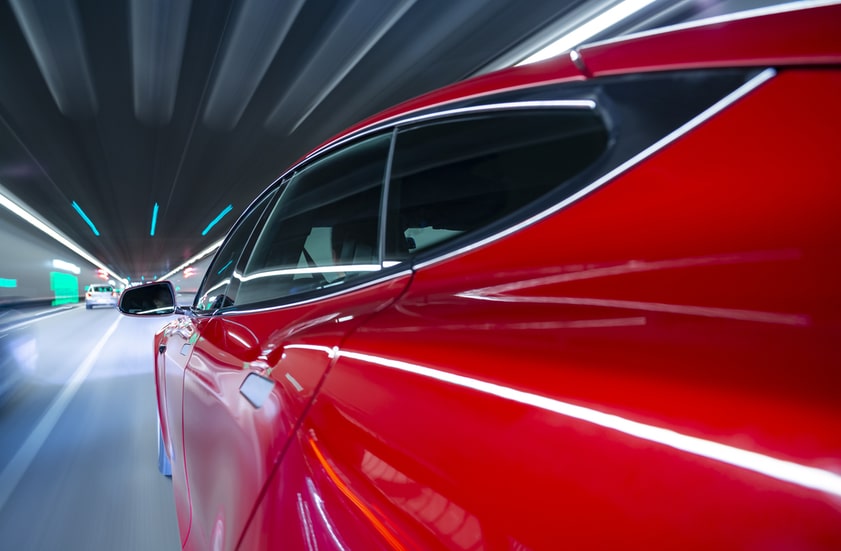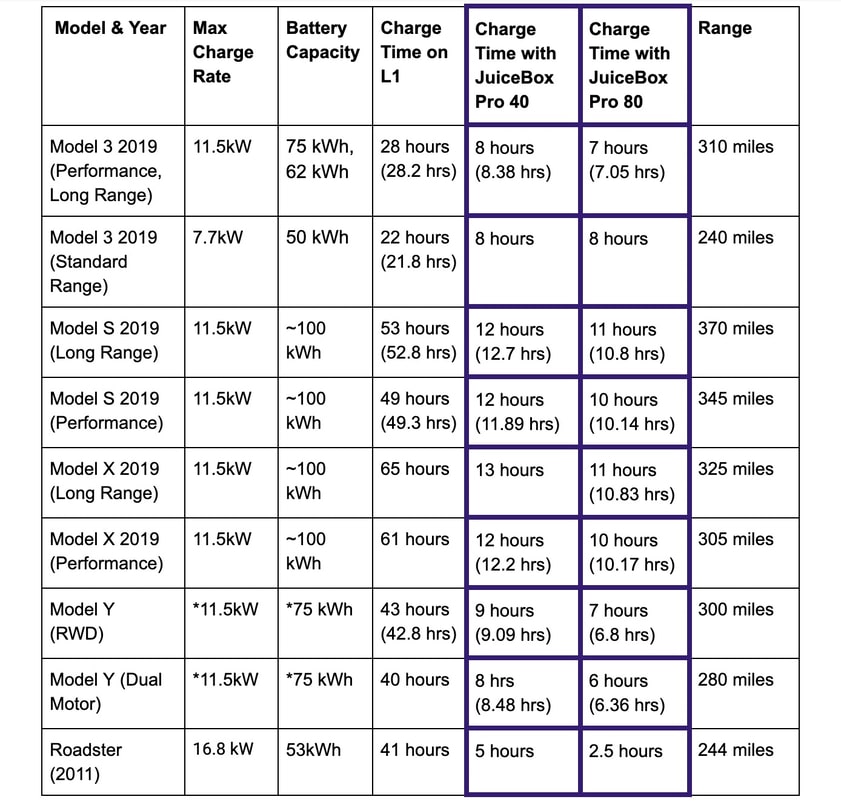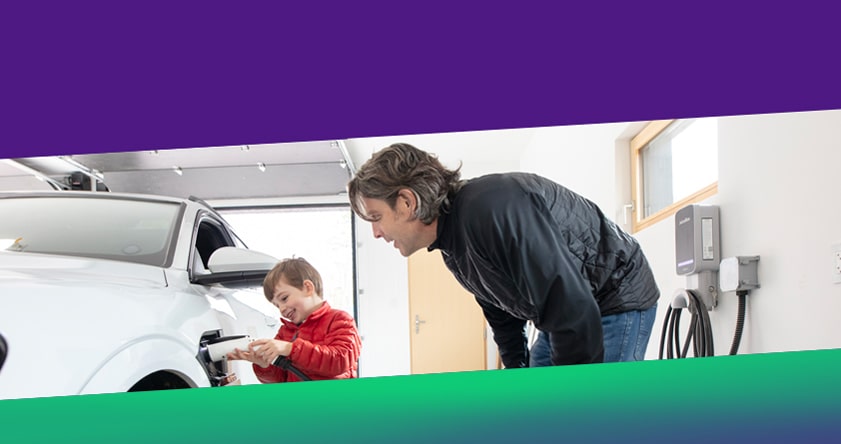How Long Does It Take to Charge a Tesla?

Tesla electric cars have become the EV industry’s gold standard, but competition is expected to intensify as more electric vehicle models come to market in the near future. The Tesla Model 3 has been an electrifying success with nearly 100,000 Model 3 sales in 2019 alone. Tesla continues to lead the battery-electric vehicle market as they scale production to meet growing consumer demand for EVs. As more consumers are going electric, many are asking questions such as: How long does it take to charge a Tesla? Is a Level 2 electric car charger right for me? How often do you have to charge a Tesla? Or how to charge a Tesla at home? In this post, we’ll take a deep dive into everything you need to know about charging your Tesla.
Tesla battery size & types of chargers
The Model S, Tesla’s flagship vehicle, is offered in several different models with varying battery capacity, power (motor size), and charging speed. The ‘Long Range’ 2019 Model S has a range of 370 miles, which is the longest electric range of any car on the road today. The Model S has a 100 kWh battery and can be charged with a variety of EV chargers. Electric vehicles can be charged with a 120-volt Level 1 charger or a 240-volt Level 2 charger as well as DCFC stations.
How to Charge a Tesla at Home
Level 1 charging stations can be plugged straight into a standard 120V outlet in your home or garage. While Level 1 systems have the ability to get the job done, they are the least efficient way to charge your EV and can take as long as 3 days to fully charge a Tesla. This painfully slow charging rate often leads a Tesla vehicle owner to depend on the Tesla public charging Supercharger network or install a home EV charger of their own.
The second home charging option for a Tesla EV driver is a Level 2 charging station that puts out the recommended 240 volts that are needed to charge your Tesla. Level 2 charging systems plug into a dedicated 50 amp circuit that may require professional electrical installation. With significantly more power than a level one charging station, Level 2 chargers can charge your Tesla roughly 6 times faster. The maximum rate at which a Tesla can charge is between 7.2kW-11.5 kW, depending on the Tesla model. So how many kWh to charge a Tesla exactly? Teslas have a battery capacity ranging from 50 kWh on the standard range Model 3 to a whopping 100 kWh that powers all Model S and Model X packages.
One question that all new EV drivers face is where to charge an electric car. At-home charging stations are the most common way to charge given it’s usually the most convenient if you have a designated parking spot. If you live in a populated area, Tesla Superchargers may have longer than expected wait times to use a charging station. A Tesla home charger allows you to charge your vehicle from the convenience of your own home. If you want to learn more about the costs between a public charging station and a home charging station, you can read our breakdown of Tesla charging station cost.
Tesla Home Charging Time
Depending on the model of Tesla an EV driver has and the type of Tesla charger they are using, charging a Tesla can take anywhere between six and twelve hours. The quickest charging time occurs within the battery’s sweet spot, which is usually between 20% and 80% of a full charge. For most Teslas, it only takes about an hour to charge from 40% to 80% on a 220V system, but another two hours to go from 80% to 100%. Due to the way ions in your car’s battery react to the shifts in electrical charge, the more ions that are charged inside the battery, the harder your Tesla car battery needs to work to seek out and charge the remaining few, greatly reducing the rate of charge as your battery nears capacity.

How do I know when my Tesla is done charging?
Each Tesla electric car is equipped to show you system diagnostics including the details on your electric car battery charge. While your Tesla is charging, it shows you how much charge you need to get home, how much charge it has, and how much longer the charging process will take.
In addition to these features, our JuiceNet platform affords additional smart charging capabilities. Via the JuiceNet app, drivers can monitor their charge, set charging schedules and receive charging notifications.
Today, electric cars are beating gas cars in many dimensions, and the out of pocket cost to recharge a Tesla EV is significantly less than the fuel costs at a gas station for a gas-powered car.
How does the charging process work?
With any lithium-ion battery, the electric vehicle charging process occurs as charged electrons move from a state of non-charge, called cathode, to a state of charge, called anode. Without getting too technical, your car is fully charged when all of the ions in your battery are pushed into a state of anode charge. Similarly, your battery is fully depleted when the ions in your battery are depleted and thrust into a cathode state. Over time, the back and forth shift from cathode to anode puts a strain on your battery capacity. Even though the battery in your Tesla is made to do exactly this task, the materials of the battery itself can only withstand so much stress over time.
The ions in your battery receive electric current and are charged one at a time. While the speed to charge a single ion happens very rapidly, the number of ions that exist within your car’s battery create a scenario wherein the entire charging process takes a long time to complete. If you’d like more on this topic, please read: How Long Does a Tesla Battery Last.
What about a Tesla Supercharger?
Today, Tesla has more than 12,000 Superchargers across North America, Europe, and Asia. In March, Tesla unveiled its V3 Supercharging, which enables Tesla electric vehicles to charge faster than any other electric vehicle on the market today. For example, a 2019 Model 3 Long Range vehicle operating at peak efficiency can recover up to 75 miles of charge in 5 minutes when using their electric vehicle charging stations and charge at rates of up to 1,000 miles per hour. It also introduced a new feature called On-Route Battery Warmup, which allows your car to intelligently heat the battery when approaching a Tesla Supercharger in order to ensure its EV drivers charge at the optimal temperature and ultimately reduce average charge times for owners by 25 percent.
Other Tesla Supercharging stations charge with up to 150 kW of power distributed between two cars with a maximum of 150 kW per car, depending on the version. These electric vehicle charging stations take about 20 minutes to charge to 50%, 40 minutes to charge to 80%, and 75 minutes to 100% on the original 85 kWh Model S.







